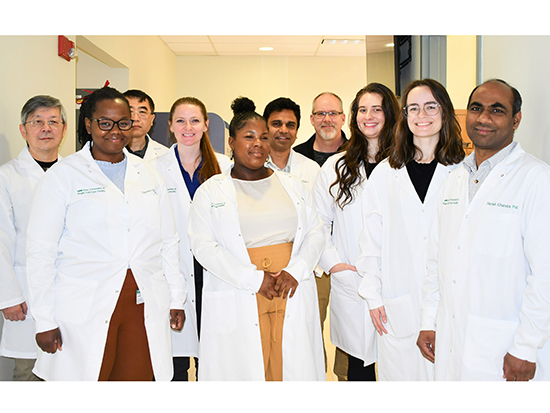 The UAB Flow Cytometry and Single Cell Core team, including Vidya Sagar Hanumanthu, MBBS (fifth from right), and Troy Randall, Ph.D. (fourth from right). Image courtesy Dr. Hanumanthu.Flow cytometry and single-cell sequencing are some of the most in-demand services in UAB’s vast research enterprise. The UAB Flow Cytometry and Single Cell Core facility is one of 15 shared resource laboratories at UAB and is one of the busiest, with an average of 600 independent appointments each month, according to FCSC associate director Vidya Sagar Hanumanthu, MBBS.
The UAB Flow Cytometry and Single Cell Core team, including Vidya Sagar Hanumanthu, MBBS (fifth from right), and Troy Randall, Ph.D. (fourth from right). Image courtesy Dr. Hanumanthu.Flow cytometry and single-cell sequencing are some of the most in-demand services in UAB’s vast research enterprise. The UAB Flow Cytometry and Single Cell Core facility is one of 15 shared resource laboratories at UAB and is one of the busiest, with an average of 600 independent appointments each month, according to FCSC associate director Vidya Sagar Hanumanthu, MBBS.
Over the past five years, the FCSC has invested $3.5 million in replacing or updating its instruments, expanding capacity, and developing new services such as multiplex immunofluorescence, Hanumanthu says. Over this period, the core was used by nearly 325 principal investigators who were supported by grants from the National Institutes of Health, the Department of Defense, and private foundations. It is often a featured stop when new research recruits are touring campus.
The core is now also one of fewer than 20 leading labs internationally to be recognized by the International Society for Advancement of Cytometry, or ISAC, through its Shared Resource Laboratory recognition program. The FCSC’s recognition, announced at the annual CYTO conference in Montreal in 2023, is valid for three years. The recognition program is designed to promote best practices to ensure reproducible data. Peer institutes honored in 2023 also include facilities at the Babraham Institute in Cambridge, U.K.; Holland’s Leiden University; and the University of Pennsylvania.
“Each week, we see faculty recruits come through the core” to see its state-of-the-art collection of research instruments, Hanumanthu said. These include a BD FACSymphony S6 six-way cell sorter, a BD FACSymphony A5 high-parameter cell analyzer, a 10x Xenium single-cell spatial imaging platform, and a Lunaphore COMET multiplex immunofluorescence instrument. “This ISAC recognition shows recruits and all research faculty at UAB that we are involved in the latest that the field has to offer, not just in the Southeast but around the country and internationally,” Hanumanthu said. The recognition should also be a benefit to faculty when applying for new grants, he adds.
 The recognition is the culmination of a detailed process that included letters of recommendation from faculty and heavy core users, a user survey, and extensive documentation of educational programs and adherence to best practices and biosafety protocols. “Recognition by ISAC shows that we have been following rigorous operations, including daily quality control and more,” Hanumanthu said.
The recognition is the culmination of a detailed process that included letters of recommendation from faculty and heavy core users, a user survey, and extensive documentation of educational programs and adherence to best practices and biosafety protocols. “Recognition by ISAC shows that we have been following rigorous operations, including daily quality control and more,” Hanumanthu said.
In addition to the latest industry best practices, the FCSC, led by director Troy Randall, Ph.D., has set a goal of offering the latest technology. “The technology is rapidly evolving,” Hanumanthu said. “As a core facility, we have to offer the best technology that is out there. If it can be done at any institute in Boston or San Francisco, we should be able to do it here. That is how we have been competing.”
Having access to the latest technologies is also a major benefit to UAB trainees. Educational seminars on new technologies such as full-spectrum flow cytometry, “the future of the field,” Hanumanthu said, “has been generating high interest from graduate students and postdocs wishing to learn about this technology.”
Meeting the extensive requirements of ISAC recognition required a major team effort by the entire FCSC group, Hanumanthu said. “I have never submitted an R01 grant [the flagship NIH grant for principal investigators], but I hear that the burden is about the same,” he said. “Recognition by ISAC is a testament to the hard work of the FCSC Core personnel and their commitment to excellence.”
New users: Start here
First-time users can learn more about working with the FCSC here.